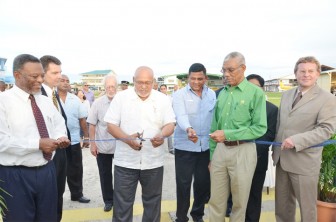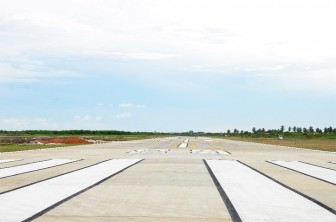Ogle Airport has moved nearer to hosting regional carriers—now expected by December—with the completion of its runway expansion.
The management of the airport, Ogle Airport Inc (OAI), last month accepted the new runway strip, marking the end of the European Union (EU)-funded project, which began in 2007.
At a simple ceremony yesterday at the main terminal building at the airport, attended by President Donald Ramotar, Opposition Leader David Granger, government officials and members of the diplomatic corps, OAI chairman Michael Correia said that the new runway is now in the Class 2 series required by the International Civil Aviation Organisation (ICAO).

He explained that 4,200-feet long runway is now capable of accommodating the Dash 8 series aircraft operated by LIAT as well as light to medium range jets, such as the Cessna Citation series aircraft. However, he said that while the second phase of the expansion project has been completed, the management of the airport will have to undertake additional works, such as the installation of runway lights, terminal enhancements, aprons, taxiways, fencing, with costs estimated in the vicinity of $400M. Some works are already in progress and the airport will be operational for regional carriers by December this year, Correia added.
The relocation of residents living in the Crown Dam, Industry area is also a major hurdle facing the airport and it is currently being addressed by the authorities.
Since the airport facilitates flights into the interior, regional and international flights as well as more recently helicopter operations to the oil rigs positioned outside the coastline, Correia said the situation presents a difficult challenge for air traffic controllers (ATCs). Against this backdrop, he noted that the country urgently needs an Automatic Dependent Surveillance (ADS) broadcast system to assist ATCs in locating air traffic while ensuring the avoidance of collisions as well as the separation of aircraft.
He added that a Very High Frequency Omni Directional Radio Range (VOR)/ DME (distance measuring equipment), and navigation aids are also needed at Ogle to ensure the safety of flights between Ogle and the Cheddi Jagan International Airport, Timehri (CJIA).
Correia also urged the president to look into the upgrade of the interior aerodromes, saying the Aircraft Owners Association through the Private Sector Commission (PSC) and as part of the National Competitiveness Strategy has been advocating that more emphasis be placed on returning interior airstrips to the standards of the early days of the Guyana Airways Corporation, when large aircraft like the CariBu and the HS-748, operated successfully using several interior airstrips.
Guyana has been rated in Category Two in terms of aviation operations by the ICAO and Correia stated that for air carriers to operate from these shores into the United States, the country must fit into Category One. Local aviator Ronald Reece will soon operate an international airline, Fly Jamaica, from Kingston, Jamaica to North America and Guyana and according to Correia, the businessman as well as other local air operators desperately wish to expand their local operations to operate international flights from these shores.

He urged the president to address the concerns of the airport’s management and make them a priority of the administration. He also said that the airport stands ready to provide its technical knowledge and support to the government and opposition “towards arriving at the political consensus which can achieve these goals and move our country forward.”
He told the president and Granger that while he recognised that at the moment they are both under tremendous pressure and face unique challenges, “I venture to suggest that there are many Guyanese out there of all types and of all walks of life who would like to help and partner with you in making our country all it can be.”
President Ramotar, in his feature address, referred to yesterday’s event as a red letter day in the history of local aviation.
He said that the government will continue to support such projects and roll out additional programmes to develop the country. “The government continues to roll out projects for the betterment of our country …I want to urge all not to create conflicts with these projects as we have seen with cuts with our budget, which will affect us deeply,” Ramotar stated, adding that the expansion project bodes well for the country and forms part of a progressive plan to develop Ogle into a major regional airport. He also noted that the project was never conceived as a means of undercutting the CJIA, since there are also major plans to modernise the country’s oldest airport.
According to Ramotar, several sectors, including the tourism, mining and forestry are benefitting from the air transport sector, to which he reiterated government’s commitment.
“Ogle is opening up our interior, not only to tourists but our economic activities,” he noted, adding that the project is predicated on a model that places private sector management of the facility in high regard. He urged that the airlines note that the public good must be kept intact, including safety as well as competitive but affordable air fares for persons to travel locally.
Earlier, EU Ambassador to Caricom Robert Kopecký said that he was proud that the project, which the EU funded to the tune of €$1.8M, has been handed over to the airport. He said that airports such as Ogle connect the countries across the Caribbean region and he was hopeful that the government will ensure the airport management or the Guyana Civil Aviation Authority (GCAA) install and operate the relevant landing and navigation aids.
The Ogle airport has been in use since the 1950s, when it began as a light aircraft strip used mainly for crop dusting by the Guyana Sugar Corporation (GuySuCo). It has over the years developed into a domestic hub for interior and coastal as well as regional flights.
In 2001, the government signed an agreement with OAI, a company which was formed by a consortium of airline operators, and the two parties had been working to upgrade the airport to internationally-accepted standards.








